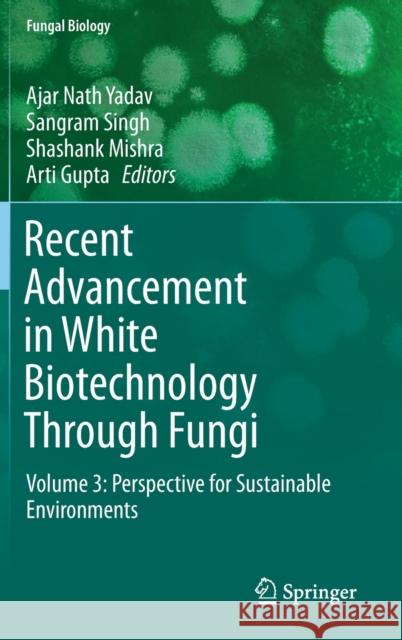Recent Advancement in White Biotechnology Through Fungi: Volume 3: Perspective for Sustainable Environments » książka



Recent Advancement in White Biotechnology Through Fungi: Volume 3: Perspective for Sustainable Environments
ISBN-13: 9783030255053 / Angielski / Twarda / 2019 / 511 str.
Recent Advancement in White Biotechnology Through Fungi: Volume 3: Perspective for Sustainable Environments
ISBN-13: 9783030255053 / Angielski / Twarda / 2019 / 511 str.
(netto: 383,36 VAT: 5%)
Najniższa cena z 30 dni: 385,52
ok. 22 dni roboczych
Dostawa w 2026 r.
Darmowa dostawa!
Preface
Chapter 1
Bioremediation: New Prospects for Environmental Cleaning by Fungal Enzymes
Dr. Neha Vishnoi, Babasaheb Bhimrao Ambedkar University, India
Chapter 2
Fungal Enzyme System for Saccharification of Lignocellulosic Feedstocks
Dr. Devendra Mani Tripathi, Bundelkhand University, India
Chapter 3 White-Rot Fungi and Their Enzymes for the Treatment of Industrial Dye EffluentsDr. P. Devagi, Tamil Nadu Agriculture University, Coimbatore, India
Chapter 4
Fungal Secretomes: Biodegradation Lignocelluloses and Biopolymers
Dr. Nasib Singh, Eternal University, Baru Sahib, India
Chapter 5
Fungal Enzymes for Bioremediation of Xenobiotic Compounds
Dr. Rajinikanth Mohan, Colgate University, NY
Chapter 6
Pleurotus ostreatus: a Biofactory for Lignin Degrading Enzymes of Diverse Industrial Applications
Dr. Hesham El Enshasy, Universiti Teknologi Malaysia (UTM), Johor Bahru, Malaysia
Chapter 7
Extracellular Fungal Peroxidases and Laccases for Waste Treatment: Recent Improvement
Dr. N. Sivakumar, Madurai Kamaraj University, Madurai, India
Chapter 8
Fungal Enzymes for Bioremediation of Contaminated Soil
Dr. Prem Chandra, Baba Saheb Bhimrao Ambedkar (A Central) University, India
Chapter 9
Fungal Enzymes for Bio conversion of Lignocellulosic Biomass
Dr Yogeshvari K. Jhala, Department of Microbiology, AAU, India
Chapter 10
Industrially Important Pigments from Different Groups of Fungi
Dr. Ashok Kumar, RGSC, Banaras Hindu University, India
Chapter 11
Bioconversion of Biomass to Biofuel using Fungal Consortium
Dr. Ch. Pavana Jyothi, GITAM University, Visakhapatnam, India
Chapter 12 Bioremediation of polycyclic aromatic hydrocarbons (PAHs) contaminated soil through fungal communityDr. Elisabet Aranda, Institute for Water Research, University of Granada, Granada, Spain
Chapter 13
Role of Fungi in Climate Change Abatement and Nitrogen Supplement
Dr. Sandeep K. Malyan,CESCRA, IARI, ND-12, India
Chapter 14
Fungal-Phytoremediation of heavy metal contaminated land and water resources: Current Scenario and Future Prospects
Dr. Amit Kumar, FIAES, Dayalbagh Educational Institute, Agra, India
Chapter 15
Biotechnological Applications of β-Glucosidases in Biomass Degradation
Dr. Sushma Mishra, Dayalbagh Educational Institute,India
Chapter16
Genetic diversity of methylotrophic yeast and their impact to the environment
Dr. Manish Kumar, Amity Institute of Biotechnology (AIB), Amity University, India
Chapter 17
Microbial enzymes and its Application in Pulp and Paper Industry
Dr. Ashish Vyas, Lovely Professional University, Phagwara, Punjab, IndiaAppendixes
Index
Over the last decade considerable progress has been made in white biotechnology research and further major scientific and technological breakthroughs are expected in the future. The first large-scale industrial applications of modern biotechnology have been in the areas of food and animal feed production (agricultural/green biotechnology) and in pharmaceuticals (medical/red biotechnology). In contrast, the productions of bio-active compounds through fermentation or enzymatic conversion are known as industrial or white biotchnology. The fungi are ubiquitous in nature and have been sorted out from different habitats, including extreme environments (high temperature, low temperature salinity and pH);and associated with plants (Epiphytic, Endophytic and Rhizospheric).
The fungal strains are beneficial as well as harmful for human beings. The beneficial fungal strains may play important roles in the agricultural, industrial, and medical sectors. The fungal strains and its product (enzymes, bioactive compounds, and secondary metabolites) are very useful for industry (e.g., the discovery of penicillin from Penicillium chrysogenum). This discovery was a milestone in the development of white biotechnology as the industrial production of penicillin and antibiotics using fungi moved industrial biotechnology into the modern era, transforming it into a global industrial technology. Since then, white biotechnology has steadily developed and now plays a key role in several industrial sectors providing both high value nutraceutical and pharmaceutical products. The fungal strains and bioactive compounds also play an important role in environmental cleaning. This volume covers the latest research developments related to value-added products in white biotechnology through fungi.
1997-2025 DolnySlask.com Agencja Internetowa
KrainaKsiazek.PL - Księgarnia Internetowa









